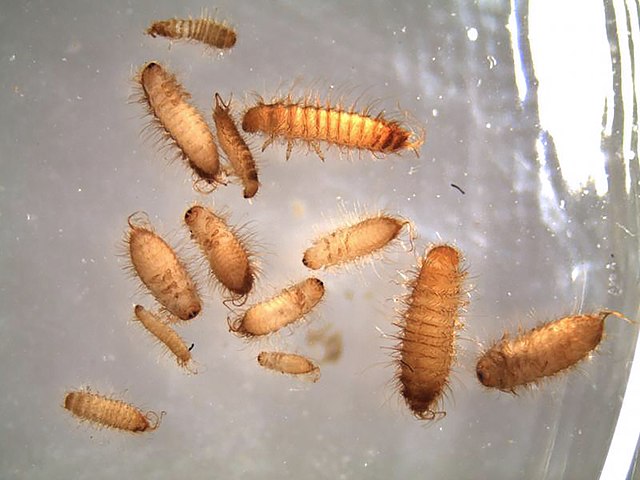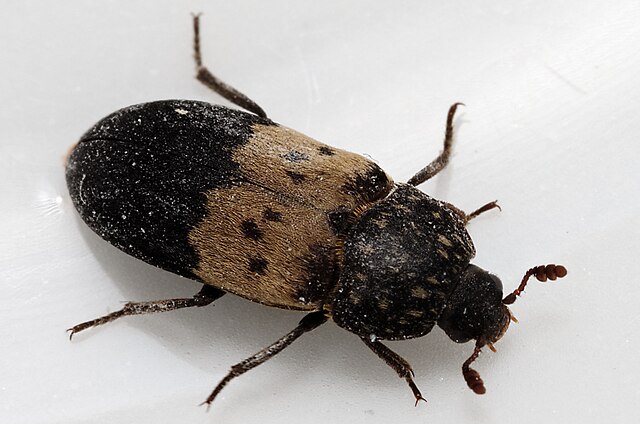Perhaps only the most pristine and perfectly sealed modern house remains insect free for very long. And if your home is as old as mine, you, your human family, and pets are most unlikely to be the only inhabitants. Have no fear though, a few invertebrates here and there do not indicate unsanitary conditions, and their very presence may well indicate that chemical exposure in your house has been minimized.
In many homes, by far the most found insect is the carpet beetle. The family Dermestidae includes carpet beetles, larder beetles, and hide beetles or skin beetles, and early in life, they are challenging to tell apart.

After hatching from eggs scarcely half as large as the period at the end of this sentence, dermestid larvae start life as fuzzy little ice-cream cone shaped larvae. A little time chowing down on natural fibers will cause them to grow, split along the seams, and shed their entire exoskeleton. The feeding, growing, and shedding process repeats so often that a single dermestid beetle larva may leave as many as ten shed exoskeletons lying about the place. Accumulated little hairy exoskeletons are often the first evidence that you have these house guests.
Once a larva eats enough of your Persian rug it will move on to its next life stage. It simply stops feeding, retreats to a quiet corner and becomes a pupa, right inside its last, and largest, larval skin. Eventually an adult beetle crawls out, seeks a mate, and repeats the life cycle.
These beetles will happily consume your favorite fur coat or taxidermy if left unchecked. They’ll also make a meal out of the woolen Aran sweater you brought back from Ireland, and they won’t turn their little beetle noses up at silk. In fact, “moth balls” could easily be renamed “beetle balls” with no extra charge for the alliteration. The dermestid menu includes most dried natural materials such as the coyote fur trim, the cotton shell, and even the feathers in those Canada Goose coats.

Ironically, my biggest fear as an entomologist is that these little beasties will get into the college’s museum drawers and reduce our treasured pinned insect collection to so many little piles of dust. On the positive side, when I need to clean a skull for the teaching collection, dermestid beetles do an amazing job. A Colchester Vermont trapper donated a couple of beaver heads to the collection a few years back, and the beetles made short work of the flesh without damaging even the most delicate bones.
But if skull cleaning is not your thing, you may be interested in ways to minimize the potential damage these beetles can do. As in medicine, prevention is better than cure. Regular vacuuming reduces the food supply for beetles while also removing insects before they are even noticed. And because dog and cat hair feature high on the dermestid beetle meal plan, pet owners may need to program their Roomba with an extra run or two!
Diatomaceous earth is abrasive at a microscopic insect scale. Sprinkled under rarely moved appliances, it works as non-toxic insect control. The abrasive texture punctures arthropod exoskeletons causing them to dry up and die.

I replace the mothballs in my insect collection twice per year, and the same routine will keep your silk pajamas or Davy Crocket hat safe from munching little invertebrates. Fake fur and other synthetic fibers are completely safe from carpet beetles; I guess they know what’s good for them. Natural fiber clothing stored in sealed containers is also well protected. But if prevention fails and you notice an unfamiliar bald patch on your taxidermy, place the entire mount in the freezer for a few days to kill the offending beetles.
While many houses will occasionally be visited by a larder beetle or other dermestid species without consequence, larger infestations are a different matter. If your house is one of the very few to experience a true infestation, it is time to call in a pest control professional to deal efficiently and safely with the problem before your wool carpets start falling apart.
But for most of us, these little beetles will be little more than a curiosity that elicits a “what’s that cute little bug”? response.
Declan McCabe is a professor of biology at Saint Michael’s College. His forthcoming book, Turning Stones: Discovering the Life Of Water is available for pre order through Down East Books at DownEastBooks.com or where ever you find your books.
Images provided by Wikimedia Commons




Comment here